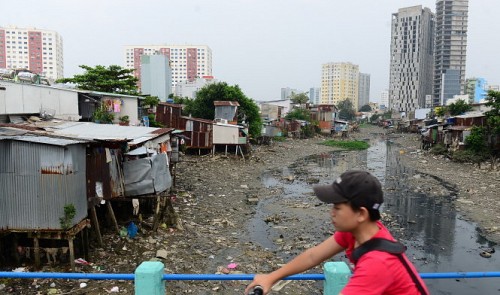Illegal houses on canals cause serious flooding in Ho Chi Minh City

Together with the city’s continuing construction boom and poor urban planning, stagnant water has caused flooding to intensify with some streets and residential areas under 0.5-1 meter of floodwater after heavy rains.
A survey by the Ho Chi Minh City Urban Drainage Company showed that 54 out of 110 large canals under its management have been partly leveled or narrowed by the illegal encroachment by housing constructions.
This figure excludes countless small streams and canals in low areas like District 2, District 7, Nha Be District, and Binh Chanh District that have been transformed by machines into construction sites.
An official of the state-run company admitted his team has dredged nearly 81 kilometers of canals in recent years while the city has a total of 5,100km of canals and rivers that need to be dredged.
Ho Chi Minh City has an average elevation of just 19 meters above sea level, so water drainage is mainly undertaken by those canals.
Most people can understand the importance of the canals, especially when the construction of a drainage system is not completed.
Canals in an ‘SOS situation’ include Cau Cut in Go Vap District, Cau Bong in District 1, Van Thanh and Xuyen Tam in Binh Thanh District, Ba Buom in District 7, Ba Tieng and Ong Bup in Binh Tan District, and No in Nha Be District.
For the Cau Cut canal, numerous temporary houses have been illegally built along both its banks, encroaching on the water flow of the waterway.
Those houses transgress each bank of Cau Cut by five to ten meters, significantly narrowing the flow of water.
In addition, littering has caused the water to become stagnant, worsening flooding after a heavy rain.
Le Thi Tuu, 70, said she saw five or six new houses that were illegally built along the Cau Cut canal during the 2000s while the remaining houses had encroached on the canal long before.
Streets near Cau Cut are often under deep water after a rain and many bike riders have fallen into the flow of the canal, unable to recognize where the street ended and the waterway began, Tuu added.
Previously, barbed wires marked both banks of canals but scrap iron pickers had taken to stealing them, Tuu recalled.
The Ba Buom canal has been in a similar situation, causing floodwater to overflow onto Huynh Tan Phat Street.
Kinh Duong Vuong Street in Binh Tan District is frequently inundated due to stagnant water from the Ba Tieng canal.
Binh Thanh is the district that has the highest number of canals unlawfully encroached on – eight out of the 54.
Despite the regularity of encroachment on canals for housing, no case has ever been cleared or fined in the last five years in the city.
Apart from local individuals, companies such as Song Kim transgressed the Cau Cut canal and Petrolimex Saigon leveled a part of the No canal in Nha Be District.
Irrigation engineer Le Thanh Cong said natural canals play a vital role in acting as reservoirs for water run-off in Ho Chi Minh City.
He cited the example of a 30-35m wide, 5m deep, and 9km long section of the Nhieu Loc – Thi Nghe canal that can contain over 1.3 million cubic meters of water. This section can significantly relieve floodwater over a wide area after rain.
Hoang Song Ha, chairman of the People’s Committee of Binh Thanh District, and Le Hoang Ha, chairman of the People’s Committee of Go Vap District, both affirmed that they do plan to clear all houses illicitly built on local canals and rivers.
What the stars mean:
★ Poor ★ ★ Promising ★★★ Good ★★★★ Very good ★★★★★ Exceptional
Latest News
More News
- Hanoi to restrict polluting vehicles across key districts (November 04, 2024 | 16:29)
- Hoan My Medical Group launches breast cancer screening to support community health (November 02, 2024 | 10:56)
- Vietnamese students explore the future at STEAMese Festival (October 28, 2024 | 16:55)
- Honouring ‘Green Warriors’ on Vietnamese Women’s Day (October 21, 2024 | 15:16)
- Swing for the Kids charity golf tournament kicks off (October 13, 2024 | 09:00)
- Swing for the Kids 2024 tees up opportunities for Vietnam's youth (October 12, 2024 | 10:00)
- HCM City approves 9 billion-USD Can Gio coastal urban development project (October 08, 2024 | 15:56)
- Nha Trang Bay submarine services pilot programme extended to next March (October 08, 2024 | 15:45)
- Swing for the Kids scholarship motivated by beneficiary’s kindness and maturity (October 08, 2024 | 12:35)
- Inflation takes focus to circumvent typhoon impact (October 04, 2024 | 17:06)


















 Mobile Version
Mobile Version